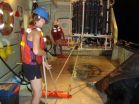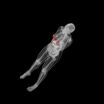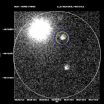(Press-News.org) New research reveals how the algae behind red tide thoroughly disables – but doesn't kill – other species of algae. The study shows how chemical signaling between algae can trigger big changes in the marine ecosystem.
Marine algae fight other species of algae for nutrients and light, and, ultimately, survival. The algae that cause red tides, the algal blooms that color blue ocean waters red, carry an arsenal of molecules that disable some other algae. The incapacitated algae don't necessarily die, but their growth grinds to a halt. This could explain part of why blooms can be maintained despite the presence of competitors.
In the new study, scientists used cutting-edge tools in an attempt to solve an old ecological mystery: Why do some algae boom and some algae bust? The research team used cultured strains of the algae that cause red tide, exposed competitor algae to its exuded chemicals, and then took a molecular inventory of the competitor algae's growth and metabolism pathways. Red tide exposure significantly slowed the competitor algae's growth and compromised its ability to maintain healthy cell membranes.
"Our study describes the physiological responses of competitors exposed to red tide compounds, and indicates why certain competitor species may be sensitive to these compounds while other species remain relatively resistant," said Kelsey Poulson-Ellestad, a former graduate student at the Georgia Institute of Technology, now at Woods Hole Oceanographic Institution, and the study's co-first author, along with Christina Jones, a Georgia Tech graduate student. "This can help us determine mechanisms that influence species composition in planktonic communities exposed to red tides, and suggests that these chemical cues could alter large-scale ecosystem phenomena, such as the funneling of material and energy through marine food webs."
The study was sponsored by the National Science Foundation and was published June 2 in the Online Early Edition of the journal Proceedings of the National Academy of Sciences (PNAS). The work was a collaboration between Georgia Tech, the University of Washington, and the University of Birmingham in the United Kingdom.
The algae that form red tide in the Gulf of Mexico are dinoflagellates called Karenia brevis, or just Karenia by scientists. Karenia makes neurotoxins that are toxic to humans and fish. Karenia also makes small molecules that are toxic to other marine algae, which is what the new study analyzed.
"In this study we employed a global look at the metabolism of these competitors to take an unbiased approach to ask how are they being affected by these non-lethal, subtle chemicals that are released by Karenia," said Julia Kubanek, Poulson-Ellestad's graduate mentor and a professor in the School of Biology and the School of Chemistry and Biochemistry at Georgia Tech. "By studying both the proteins and metabolites, which interact to form metabolic pathways, we put together a picture of what's happening inside the competitor algal cells when they're extremely stressed."
The research team used a combination of mass spectrometry and nuclear magnetic resonance spectroscopy to form a holistic picture of what's happening inside the competitor algae. The study is the first time that metabolites and proteins were measured simultaneously to study ecological competition.
"A key aspect of this study was the use of high-resolution metabolomic tools based on mass spectrometry," said Facundo M. Fernández, a professor in the School of Chemistry and Biochemistry, whose lab ran the mass spectrometry analysis. "This allowed us to detect and identify metabolites affected by exposure to red tide microorganisms."
Mass spectrometry was also used for analysis of proteins, an approach called proteomics, led by Brook Nunn at the University of Washington.
The research team discovered that red tide disrupts multiple physiological pathways in the competitor diatom Thalassiosira pseudonana. Red tide disrupted the energy metabolism and cellular protection mechanisms, inhibited their ability to regulate fluids and increased oxidative stress. T. pseudonana exposed to red tide toxins grew 85 percent slower than unexposed algae.
"This competitor that's being affected by red tide is suffering a globally upset state," Kubanek said. "It's nothing like what it would be in a healthy, normal cell."
The work shows that chemical cues in the plankton have the potential to alter large-scale ecosystem processes including primary production and nutrient cycling in the ocean.
The research team found that another competitor diatom, Asterionellopsis glacialis, which frequently co-occurs with Karenia red tides, was partially resistant to red tide, suggesting that co-occurring species may have evolved partial resistance to red tide via robust metabolic pathways.
Other work in Kubanek's lab is examining red tide and its competition in the field to see how these interactions unfold in the wild.
"Karenia is a big mystery. It has these periodic blooms that happen most years now, but what's shaping that cycle is unclear," Kubanek said. "The role of competitive chemical cues in these interactions is also not well understood."
INFORMATION:
This research is supported by the National Science Foundation under award number OCE-1060300. Any conclusions or opinions are those of the authors and do not necessarily represent the official views of the sponsoring agency.
CITATION: Kelsey L. Poulson-Ellestad, et al., "Metabolomics and proteomics reveal impacts of chemically mediated competition on marine plankton." (June, PNAS) http://www.pnas.org/cgi/doi/10.1073/pnas.1402130111
How red tide knocks out its competition
2014-06-04
ELSE PRESS RELEASES FROM THIS DATE:
New diagnostic imaging techniques deemed safe in simulations
2014-06-04
DURHAM, N.C. -- Gamma and neutron imaging offer possible improvements over existing techniques such as X-ray or CT, but their safety is not yet fully understood. Using computer simulations, imaging the liver and breast with gamma or neutron radiation was found to be safe, delivering levels of radiation on par with conventional medical imaging, according to researchers at Duke Medicine.
The findings, published in the June issue of the journal Medical Physics, will help researchers to move testing of gamma and neutron imaging into animals and later humans.
Conventional ...
Study: When hospital workers get vaccines, community flu rates fall
2014-06-04
Anaheim, Calif., June 4, 2014 – For every 15 healthcare providers who receive the influenza vaccination, one fewer person in the community will contract an influenza-like illness, according to a study using California public health data from 2009 – 2012.
In an abstract that will be presented on June 7 at the 41st Annual Conference of the Association for Professionals in Infection Control and Epidemiology (APIC), a researcher analyzed archival data from the California Department of Public Health to determine the relationship between vaccinating healthcare personnel against ...
MU scientists successfully transplant, grow stem cells in pigs
2014-06-04
COLUMBIA, Mo. – One of the biggest challenges for medical researchers studying the effectiveness of stem cell therapies is that transplants or grafts of cells are often rejected by the hosts. This rejection can render experiments useless, making research into potentially life-saving treatments a long and difficult process. Now, researchers at the University of Missouri have shown that a new line of genetically modified pigs will host transplanted cells without the risk of rejection.
"The rejection of transplants and grafts by host bodies is a huge hurdle for medical researchers," ...
Saturated fat intake may influence a person's expression of genetic obesity risk
2014-06-04
Boston, MA (June 4, 2014) ─ Limiting saturated fat could help people whose genetic make-up increases their chance of being obese. In a new study, researchers from the Jean Mayer USDA Human Nutrition Research Center on Aging (USDA HNRCA) at Tufts University identified 63 gene variants related to obesity and used them to calculate a genetic risk score for obesity for more than 2,800 white, American men and women enrolled in two large studies on heart disease prevention. People with a higher genetic risk score, who also consumed more of their calories as saturated fat, ...
Ice cream sensations on the computer
2014-06-04
Changes in coldness, creaminess or texture that we experience in the mouth while we are eating an ice cream can be visualised on a screen using coloured curves. Graphs help manufacturers improve product quality, as proven by researchers at the Institute of Agrochemistry and Food Technology in Valencia, Spain.
In the last five years a technique known as 'Temporal Dominance of Sensations' (TDS) has become popular, used to analyse how consumer impressions evolve from the moment they taste a product.
Researchers at the Institute of Agrochemistry and Food Technology (CSIC) ...
Weight loss surgery also safeguards obese people against cancer
2014-06-04
Weight loss surgery might have more value than simply helping morbidly obese people to shed unhealthy extra pounds. It reduces their risk of cancer to rates almost similar to those of people of normal weight. This is the conclusion of the first comprehensive review article taking into account relevant studies about obesity, cancer rates and a weight loss procedure called bariatric surgery. Published in Springer's journal Obesity Surgery, the review was led by Daniela Casagrande of the Universidade Federal do Rio Grande do Sul in Brazil.
With bariatric surgery, a part ...
Observed by Texas telescope: Light from huge explosion 12 billion years ago reaches Earth
2014-06-04
Intense light from the enormous explosion of a star more than 12 billion years ago — shortly after the Big Bang — recently reached Earth and was visible in the sky.
Known as a gamma-ray burst, light from the rare, high-energy explosion traveled for 12.1 billion years before it was detected and observed by a telescope owned by Southern Methodist University, Dallas.
Gamma-ray bursts are believed to be the catastrophic collapse of a star at the end of its life. SMU physicists report that their telescope was the first on the ground to observe the burst and to capture an ...
A new approach to diversity research
2014-06-04
When people work in socially homogeneous groups, they overestimate their own contributions to the group's success, according to a new study co-authored by an MIT scholar. In fact, in some cases such "self-serving bias" occurs to a degree about five times as great in homogeneous groups as in ethnically diverse groups.
Such results raise a larger point, suggests Evan Apfelbaum, the W. Maurice Young Assistant Professor of Organization Studies at the MIT Sloan School of Management, and the lead author of the new study: Researchers have often used homogeneous social groups ...
NASA should maintain long-term focus on Mars as 'horizon goal' for human spaceflight
2014-06-04
WASHINGTON – Arguing for a continuation of the nation's human space exploration program, a new congressionally mandated report from the National Research Council concludes that the expense of human spaceflight and the dangers to the astronauts involved can be justified only by the goal of putting humans on other worlds. The report recommends that the nation pursue a disciplined "pathway" approach that encompasses executing a specific sequence of intermediate accomplishments and destinations leading to the "horizon goal" of putting humans on Mars. The success of this approach ...
Multilingual or not, infants learn words best when it sounds like home
2014-06-04
Los Angeles, London (June 04, 2014). Growing up in a multilingual home has many advantages, but many parents worry that exposure to multiple languages might delay language acquisition. New research could now lay some of these multilingual myths to rest, thanks to a revealing study that shows both monolingual and bilingual infants learn a new word best from someone with a language background that matches their own.
While 1.5 year old babies are powerful word learners, they can have difficulty learning similar-sounding words (e.g., "coat" and "goat"). A string of previous ...




